The third generation of Latin bands, after twenty years of implantation in Madrid, is probably the one that presents the most changes with respect to the previous ones. Both the experts from the National Police and the Civil Guard who work against this scourge agree that the origin of the members of these criminal organizations is much more diverse than just a few years ago. This is what they assure ABC. The return to normality after the lockdown due to the Covid-19 pandemic has led to greater criminal activity; but also a change in the profiles of these young people.
So much so, that in one of the emerging bands the surname 'Latina' is merely testimonial. This is the case of the Bloods, among whose ranks Moroccans are already the majority.
This is confirmed by reliable police sources, who estimate that 90% of its members were born in that area of the Maghreb, have been naturalized Spaniards or descend directly from parents from the neighboring country.
«They are of that origin and with a difference, compared to what happened when they emerged. This is due to the group feeling, because they feel more cared for by the group than by their own family. They move mainly through the central area, which is traditionally the territory of the Trinitarians, but they have a union or non-aggression pact with them, ”explains a researcher.
This trend is going further, says another specialist from the Armed Institute: «It is a generalized context of all gangs in general; They are increasingly heterogeneous in terms of nationalities. And this is because their purpose is to seek followers of any kind, and where they are most vulnerable to succumbing to recruitment are usually in marginal or most disadvantaged areas, which in turn tends to coincide with a high percentage of the The population of this area is usually of very diverse nationalities.
Therefore, it is not surprising that among these Moroccans there are unaccompanied foreign minors (mena) or who have been and, when they turn 18, have been stranded on the street. And it is in this context that they seek and find their 'place' in youth gangs.
In the demarcation of the National Police (the capital and 14 other large municipalities), there are officially 120 Trinitarios; 120 Dominican Don't Play (DDP), which are considered even more violent than the first; 40 Bloods; 40 Ñetas, and there are barely 20 Latin Kings left, the original group. In total, counting other very minority organizations, the active and affiliated members of the Latin gangs in Madrid exceed 400.
The most worrying thing is, without a doubt, the greater youth of these kids. In 2020, minors were 20%; in 2021, 32%; and currently exceed 40%. Children between 12 and 14 years old are being captured, the age limit to start having criminal responsibility. An example was the last murder, at the end of April, on Calle de Alcocer, in Villaverde: of the seven detainees, the youngest is considered the perpetrator, who had only been 14 years old for a month.
The pyramidal structure, so ingrained in the first youth gangs that arrived from South and Central America in the early 2000s, has today mutated into heterogeneous groups, increasingly anarchic and stripped of blind obedience to their leaders. This circumstance in organizations as numerous as the Trinitarians or the DDP has particular repercussions on the almost non-existent ties that their different factions currently maintain. In the case of the Bloods, much smaller in number, the connections remain firmer, albeit with limitations.
Due to the greater presence of Moroccans or Spaniards whose parents were born on the other side of the Strait, the detection by the Police of a new figure, the 'bulteros' (those individuals who do not belong to any gang, but who attribute such condition to when committing crimes, such as robberies in the Metro and in institutes), which leaves a smaller skeleton but not without fissures. Thus, it is no coincidence that in October of last year, one of the bosses, known as 'supremas', ordered from Barcelona the murder of a young man who had recently left the gang and who was then residing in Madrid. For this reason, he entrusted the mission to the 'bloc' (faction) based in the capital.
The conversations intercepted by the Civil Guard precipitated an operation to prevent crime and behead the 'blocks' of Madrid, Barcelona and the Basque Country. The Bloods had to be refounded again. And they didn't take long to do it. In November, the National Police arrested four gang members for sexually abusing a minor and threatening her with a knife during a party held in an apartment in Tetuán. Of those arrested, three men, one of them a minor, and a woman, the most violent was a 19-year-old Moroccan with multiple records for robbery with violence, resistance and crimes against property.
Already in March of this year, the agents of the Armed Institute lay down the glove to a violent cell based in the Corredor del Henares. In total, another 14 members arrested, three of Dominican origin nationalized Spanish, a Moroccan and six from our country, accused of inflicting numerous beatings on young people, threats and mass attacks such as the one suffered by a teenager in his family chalet in Alovera (Guadalajara). ). Nearly 60 gang members went to his house with the purpose of assaulting it for a matter that had nothing to do with the youth gangs themselves. This, however, did not prevent one of the attackers from carrying a bolomachete with a 40-centimeter blade, as can be seen in one of the videos they recorded as they marched towards the house.
The Security Forces and Bodies closely monitor potential incorporations into this type of gang, classified as criminal organizations, based on the system of roles defined through a system of task distribution and the stable nature of such criminal activities. The problem comes when some gangs claim to belong to these groups (or to 'new' groups created by themselves) in schools and institutes in order to intimidate the rest of their classmates.












